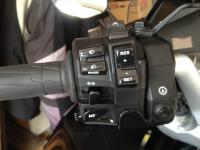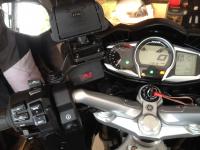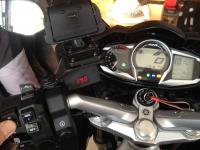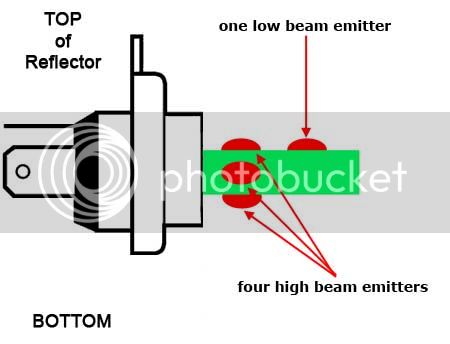That's a good point about point about the high beam. The halogen bulbs provide a 360 degree illumination from that filament whereas these particular LEDs do not. That is probably the same reason the fanless ones failed to perform well in my Honda Pilot (post #46).Fred, this is exactly how the H4 LED conversions work, i.e., the high-beam LED is powered-on (lit) at the same time as the low-beam LED. Both emitters light up, providing light from both sides of the unit to the reflector, to be cast down the road.This is exciting.
So, the best way to run the H4 LED conversion lamps would be (unlike the H4 Halogens) to run the upward emitting LED only while in low beam mode, but to then run both Up and down LEDs when in high beams!! This is brilliant!! (sorry for the bad pun) as it will eliminate one of the major foibles of the FJR headlamp buckets from day one, lack of foreground illumination on high beam.
The problem, and it's a BIG one, is that due to the design of these units, the high-beam LED is only pointing down, towards the bottom of the reflector, exactly like the low-beam LED is only pointing up, at the top of the reflector. This gives full coverage of the low-beam, even in high-beam mode, but the light from the high-beam emitter is only illuminating half of the reflector.
So in high-beam mode, you get all the benefits of low-beam, but only half of what you should be getting from the high-beam emitter.
Again, take a look at the picture I posted above and you'll see the amount of shadows created when the LED is in high-beam mode, i.e., both high and low emitters lit at the same time.
I think that's why SO many FJRs seem to have their headlights aimed too high...to get the "correct" low-beam, the high-beam is simply too high. But with the high-beam set "just right" you get a "dark spot" in front of the bike.Even with the halogen lamps (that it was designed for) the high beam was always pretty bad because it shifted all of the light up too high, into too small of a vertical range that the reflector was focused at, and it left the foreground nearly dark. I understand the idea that you do not want too much scatter or foreground illumination when on high beam as it diminishes your distance vision, but it was excessively focused previously, and this seems like the panacea of FJR lighting.
I don't think that would be an issue with these LEDs. They (through their own "ballast") provide power to both emitters. The big fly in the ointment is the high-beam emitters just don't function the same as high-beam H4 halogens or HIDs. It's not the quality of the light...it's the quantity.It will require rewiring your bike slightly since the headlight relays will only want to run either the high or low beam LEDs, but with the reduced power consumption of LEDs we should have plenty of overhead power capacity to run both LEDS simultaneously and still be below the draw of the 55W halogen high beams alone.
There does appear to be LEDs on the market that have a 360 degree design (and no cooling devices?) for those 'single filament' applications. I'm thinking if the best design for an H4 LED would be to have a combination of a directional low beam chip and a ring of 360 degree chips for the high beam.
My dream auxillary light set up is to have either the Hella Bi-Xenon or Bi-LED headlight modules in addition. You would have to make up custom brackets though. Also big $$$.... $1,200-$1,400 per pair!
https://www.rallylights.com/all/lights/headlamps/90bl-hella-bi-led-90mm-headlamp-module-hi-low-beam.html
https://www.rallylights.com/all/lights/headlamps/hella-bi-xenon-90mm-hi-lo-headlamp.html



































































